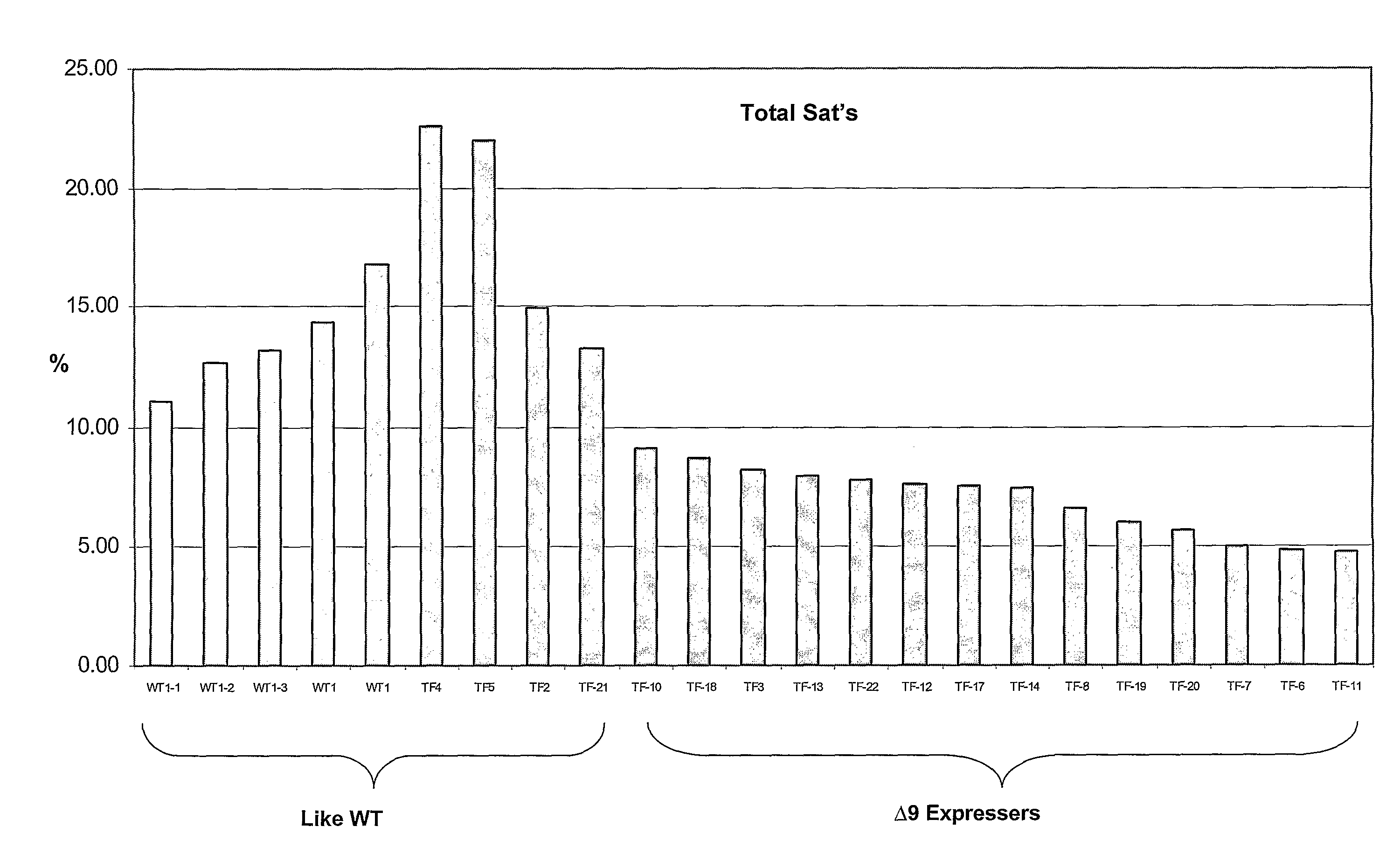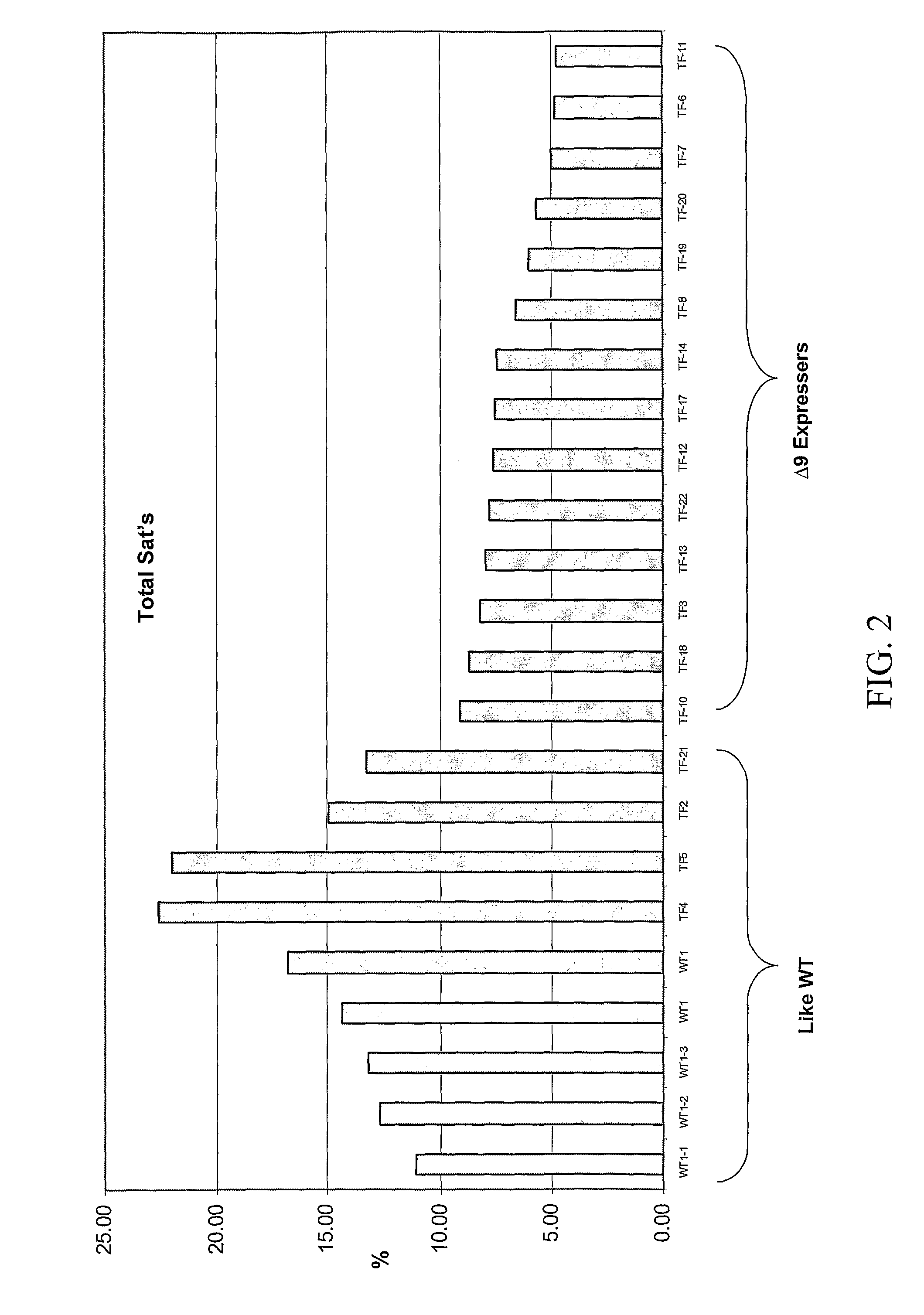Certain Plants with "No Saturate" or Reduced Saturate Levels of Fatty Acids in Seeds, and Oil Derived from the Seeds
a technology of fatty acids and plants, which is applied in the field of certain plants with "no saturate" or "reduce saturate levels of fatty acids in seeds, and oil derived from seeds, can solve the problems of general uncertainty in the achievement of desired goals of mutagens, loss or decrease of a particular function, and inability to disclose how any particular oilseed plant could be modified, etc., to achieve advantageous characteristics and fatty acid profiles, reduce saturated fatty acids, and reduce levels of total saturated
- Summary
- Abstract
- Description
- Claims
- Application Information
AI Technical Summary
Problems solved by technology
Method used
Image
Examples
example 1
Delta-9 Desaturase Gene Rebuilding
[0121]A delta-9 desaturase gene of the subject invention was redesigned for plant expression through a combination of changing Aspergillus nidulans sequence to plant-preferred translational codons, introducing unique restriction enzyme sites, and removing unwanted sequences and some secondary structure. The redesigned gene was synthesized by Operon, Inc. The sequence of the open reading frame for this polynucleotide is provided here as SEQ ID NO:1. The sequence of the ORF preceded by a Kozak sequence and a BamHI cloning site (caps), plus a translational terminator at the end of the ORF (caps), is provided in SEQ ID NO:2.
example 2
Delta-9 Desaturase Plant Transformation Vector Construction
[0122]The BamHI-BstE11 gene fragment was cloned into a vector between the Pv beta-phaseolin promoter and Pv beta-phaseolin 3′ UTR (pPhas-UTR). This construct was named pOIL. The promoter-gene-UTR fragment was excised from pOIL by digestion with NotI, blunted, and cloned into the blunt Pme1 site of vector pOEA1. The final vector was named pPD9-OEA1.
example 3
Plant Transformation with pPD9-OEA1
[0123]Plasmid vector pPD9-OEA1 was transformed into Agrobacterium tumefaciens [strain C58GV3101 (C58C1RifR) pMP90 (GmR). Koncz and Schell, Mol. Gen. Genet (1986)]. The delta 9-desaturase plants were then obtained by Agrobacterium tumefaciens mediated plant transformation
[0124]Arabidopsis was transformed with the “dip method,” a procedure well known in the art. Plants were selfed, and dried seed was collected for FAME (fatty acid methyl ester) analysis.
[0125]The protocol used for canola transformation was as described by Katavic [Katavic, Campbell, L., Friesen, L., Palmer, D., Keller, W., and Taylor, D. C. (1996), “Agrobacterium-mediated genetic transformation of selected high erucic acid B. napus cultivars,” 4th Canadian Plant Tissue Culture and Genetic Engineering Conference, Saskatoon, SK, Jun. 1-4, 1996], with modifications for DAS's Nexera line. Hypocotyl sections were isolated from 6-day-old seedlings of B. napus, cv Westar or Nexera 710 and w...
PUM
| Property | Measurement | Unit |
|---|---|---|
| weight | aaaaa | aaaaa |
| height | aaaaa | aaaaa |
| temperatures | aaaaa | aaaaa |
Abstract
Description
Claims
Application Information
 Login to View More
Login to View More - R&D
- Intellectual Property
- Life Sciences
- Materials
- Tech Scout
- Unparalleled Data Quality
- Higher Quality Content
- 60% Fewer Hallucinations
Browse by: Latest US Patents, China's latest patents, Technical Efficacy Thesaurus, Application Domain, Technology Topic, Popular Technical Reports.
© 2025 PatSnap. All rights reserved.Legal|Privacy policy|Modern Slavery Act Transparency Statement|Sitemap|About US| Contact US: help@patsnap.com



